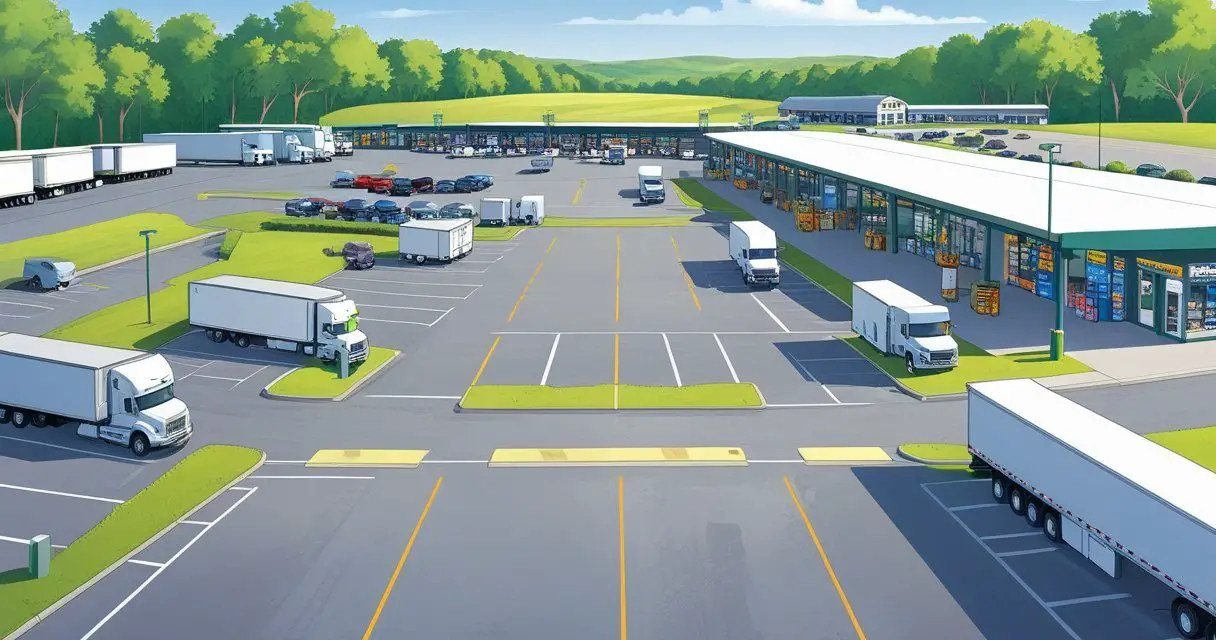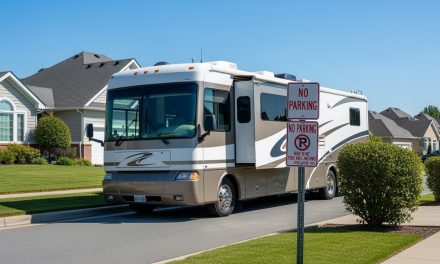Would you like to save this article?
Long drives can wear you down. Sometimes all you need is a safe, convenient place to rest.
Truck stops often seem like the perfect solution—large lots, easy access, and plenty of amenities. Yes, you can park your RV at many truck stops, but you must follow the rules and respect the space reserved for professional drivers.
Some major chains, like Flying J and Love’s, welcome RVs with designated parking areas or even paid spots with hookups. Others may allow overnight stays only if space permits.
Knowing where and how to park helps you avoid conflicts with truckers who rely on these stops for their required rest breaks. Planning ahead and practicing good etiquette will make your stop smoother and safer.
A little courtesy—like buying fuel or keeping slides in—goes a long way toward keeping truck stops open to RVers.
Key Takeaways
- Many truck stops allow RV parking when you follow proper guidelines
- Some locations offer dedicated RV spaces or paid overnight options
- Respecting truckers’ needs and parking rules ensures a positive experience
Can RVs Park at Truck Stops Legally?
You can usually park your RV at a truck stop, but the rules depend on local laws, company policies, and the type of facility. Some areas allow overnight stays freely, while others limit parking time or require permission from staff.
State and Local Regulations
Parking laws for RVs vary by state and city. Some states allow overnight parking at truck stops as long as you follow posted signs and don’t block traffic or commercial vehicles.
Others restrict overnight stays to designated rest areas or campgrounds. Local ordinances often control how long you can remain parked.
Some cities limit stays to 8 or 12 hours. Others ban overnight parking altogether.
You should check for “No Overnight Parking” signs or contact local authorities before stopping. Violating parking laws can result in fines or towing.
Using a travel app or state Department of Transportation website helps you confirm current regulations before you arrive.
Differences Between Truck Stops and Rest Areas
Truck stops and rest areas serve different purposes. Truck stops are private businesses that sell fuel, food, and other services.
Rest areas are public facilities managed by state highway departments. At a truck stop, you’re on private property, so the owner sets the rules.
You might find designated RV spaces, dump stations, and hookups. Some charge a small fee for overnight use.
Rest areas are free but have time limits, often between 2 and 8 hours. They’re meant for short breaks, not camping.
You can usually sleep in your RV there, but you can’t extend awnings or set up outdoor gear.
Company Policies on RV Parking
Major truck stop chains like Pilot Flying J, Love’s, and TA/Petro generally allow RV parking. Many locations even have separate RV areas with fuel pumps and dump stations.
However, policies differ by location because each site operates under local management. You should always ask the attendant before staying overnight.
Some locations restrict RVs when parking is full or reserved for trucks. To be courteous, park in designated RV or car areas, keep slides and awnings in, and move after fueling.
Buying fuel or food shows appreciation and helps maintain good relationships with truck stop owners.
Types of Truck Stops That Allow RV Parking
You can find RV parking at both large truck stop chains and smaller independent stops. Each type offers different levels of access, services, and space for RVs.
Knowing what to expect helps you plan better and avoid problems on the road.
Major Chains and Their Policies
Large travel center chains such as Pilot/Flying J, Love’s Travel Stops, and TA/Petro are among the most RV-friendly options. These companies often have dedicated RV parking, dump stations, and fuel lanes designed for larger vehicles.
Pilot/Flying J provides RV-specific services, including propane refills, potable water, and dump stations at many locations. You can use their app to find sites with RV amenities and check fuel prices.
Membership programs like Good Sam or the RV Plus Card can give you discounts on fuel and services. Love’s Travel Stops has expanded its network with Love’s RV Stops, which feature hookups for electricity, water, and sewer.
Some sites include dog parks and picnic areas. You can reserve spaces through their website or app, and many locations offer 24-hour assistance.
TA/Petro Travel Centers also welcome RVers, offering dump stations, propane, and restaurants on-site. Their StayFit program adds walking paths and fitness areas, which can be useful during long trips.
Their app helps you locate RV-friendly facilities and reserve showers ahead of time.
Independent Truck Stops
Independent truck stops vary widely in quality and RV access. Some offer plenty of space and welcome RVs, while others focus mainly on commercial trucks.
Always check signs or ask staff before parking overnight. Many independent stops are located along less-traveled routes.
These can be quieter and less crowded than big chains. However, they may not have dedicated RV lanes or hookups, so you’ll need to be more self-sufficient.
You can find these stops through mapping apps, RV travel apps like AllStays, or local recommendations. Smaller operators often appreciate RV business, especially if you buy fuel or food from them.
Always park away from truck lanes to avoid blocking drivers who need rest breaks.
Amenities for RVs
Truck stops that allow RV parking usually provide basic services such as fuel, food, restrooms, and showers. Some offer additional conveniences like laundry, potable water, dump stations, and propane refills.
Many large chains have 24/7 access, making them useful for late-night arrivals. Some locations charge small fees for dump stations or water fills, while others include them with fuel purchases.
If you travel often, using apps from major chains helps you find spots that meet your needs. These tools show available amenities, fuel prices, and parking availability in real time.
When using any truck stop, park out of the main truck lanes and follow posted rules to stay courteous and safe.
How to Find Truck Stops for RV Parking
You can locate RV-friendly truck stops by using mapping tools, contacting locations before arrival, and reading posted signs once on-site. Each method helps confirm parking availability, size limits, and any fees before you pull in for the night.
Using Apps and Online Maps
You can use travel and navigation apps to find truck stops that allow RV parking. Google Maps, RV LIFE, AllStays, and TruckMap often list parking details, fuel types, and available amenities.
When using these tools, check user reviews for notes about space size, lighting, or noise levels. Many RVers leave comments about whether the location felt safe or had designated RV spots.
To narrow your search, filter by RV parking, dump stations, or hookups. Some apps also show Love’s RV Stops or Pilot/Flying J locations that offer paid or free overnight parking.
Keep your maps updated, as truck stops sometimes change their parking policies or add new RV sections.
Contacting Truck Stops Directly
Calling ahead helps you avoid surprises. Truck stops vary in how much space they have and whether they reserve spots for RVs.
Ask if overnight parking is allowed, if there’s a time limit, and whether you need to check in at the counter. Some chains, like Love’s or TA/Petro, have customer service numbers or websites where you can confirm availability.
If the location charges a small fee for hookups or reserved spaces, you can often pay online or by phone. When you call, note details such as maximum vehicle length, quiet hours, and fuel island access.
This information helps you plan your stop efficiently and avoid blocking truck lanes.
Signs and On-Site Information
Once you arrive, look for posted signs that indicate where RVs can park. Many truck stops separate truck and RV areas to keep traffic organized.
Signs may show time limits, overnight rules, or designated RV sections near the convenience store or rest area. Follow these directions to stay compliant and avoid being asked to move.
If you’re unsure, ask an employee where to park. Staff usually know which areas stay quietest or have space for slide-outs.
Observing posted rules and markings ensures you park safely and respectfully.
Best Practices for Parking Your RV at Truck Stops
You can safely and respectfully park your RV at a truck stop by choosing an appropriate space, staying out of truck-only areas, and taking simple steps to secure your vehicle and belongings. Paying attention to these details helps you rest comfortably while avoiding conflicts with professional drivers.
Choosing the Right Parking Spot
Look for designated RV or car parking areas first. Many large truck stops, such as Pilot, Love’s, or TA, have sections for smaller vehicles or RVs.
These spots are usually near the main building but away from the truck fueling lanes. If no RV spaces exist, park on the car side of the lot or along the outer edge where you won’t block traffic flow.
Avoid tight spaces that make it difficult for trucks to maneuver. Use these quick checks before stopping:
- Make sure your slide-outs and awning can remain retracted.
- Confirm that lighting is adequate for visibility at night.
- Keep clear of fueling lanes, entrances, and exits.
Parking in a well-lit, low-traffic area gives you easier access to restrooms and food while keeping noise and congestion to a minimum.
Avoiding Truck-Only Spaces
Truck stops serve as mandatory rest points for truck drivers who must log specific sleep hours. Taking a truck-only space can prevent them from meeting legal rest requirements.
You should never park in the long, back-row spaces marked for semis or near diesel pumps. Even if several are empty, truckers arrive at all hours, and those spots fill quickly.
Instead, look for signage or pavement markings that identify non-truck parking zones. If you’re unsure, ask an employee where RVs are allowed.
Keep your RV compact by avoiding slide-outs and exterior setups. Don’t place chairs, grills, or other gear outside your vehicle.
Treat your stop as a short rest, not a campsite.
Securing Your RV
Truck stops are busy, so take basic security steps. Lock all doors and compartments, and close windows before going inside.
Keep valuables out of sight, and avoid leaving electronics visible through the windshield. When possible, park under lights or near surveillance cameras.
Motion lights and small alarms can also deter theft. Be cautious of anyone approaching your RV.
If someone tries to start a conversation about money or offers unsolicited help, politely decline and move on. Staying alert and limiting distractions helps you remain safe while you rest.
Etiquette and Safety Tips for RV Parking at Truck Stops
When staying overnight at a truck stop, you must balance convenience with courtesy and safety. Respect for professional drivers, control of noise and light, and awareness of your surroundings help you rest without causing problems or drawing unwanted attention.
Respecting Truck Drivers
Truck drivers rely on truck stops for legally required rest breaks. You should always give them parking priority since they cannot easily find other places to stop.
Avoid parking in spaces marked for trucks or blocking their routes to fuel pumps and service areas. If a trucker approaches you about your parking spot, respond politely and move if needed.
A respectful attitude helps prevent tension and keeps everyone safe. When fueling, pull forward after filling up before going inside.
This keeps fuel lanes open for drivers on tight schedules.
Quick reminders:
- Park only in designated RV or car areas.
- Keep slides and awnings in when possible.
- Avoid setting up outdoor furniture or grills.
These small actions show consideration for those working on the road.
Minimizing Noise and Light
Truck stops operate 24 hours a day. Keeping your area quiet and dark helps you and others rest better.
Turn off generators when not needed. Avoid idling your engine for long periods.
Use blackout curtains or window covers to block bright lights from signs and passing vehicles. Dim interior lights at night to reduce glare for nearby drivers.
If you need to step outside, close doors softly. Keep conversations low.
Many truckers sleep during odd hours, and extra noise can disturb their rest.
Tips for a calmer stay:
- Choose a parking spot away from main entrances or fuel pumps.
- Avoid playing music outside your RV.
- Use low-beam lights when arriving or leaving after dark.
Personal Safety Precautions
Truck stops are generally safe, but you should still take basic precautions. Lock your doors, close windows, and keep valuables out of sight.
Park under good lighting and near other occupied vehicles when possible. Be cautious of strangers who approach your RV.
It’s fine to be friendly, but avoid sharing personal travel details. Do not open your door to anyone you don’t know.
If someone makes you uncomfortable, move your RV or contact truck stop staff. Many locations have security cameras or attendants who can help.
Safety checklist:
| Action | Why It Matters |
|---|---|
| Lock doors and compartments | Prevents theft or intrusion |
| Stay aware of surroundings | Reduces risk of scams or distractions |
| Park in visible areas | Increases safety and visibility |
Alternatives to Truck Stop RV Parking
You can find safe and convenient overnight parking in many places besides truck stops. Some locations provide more space, quieter surroundings, or extra amenities that make your stay more comfortable.
Rest Areas
Rest areas offer a simple and legal place to stop for short stays. They are located along highways and are designed for drivers who need a quick break.
Most allow parking for a few hours, though overnight stays may have time limits that vary by state. You can expect restrooms, picnic areas, and vending machines, but not hookups or dump stations.
These stops are best for short rest periods rather than extended stays. To stay safely, park in designated areas and avoid blocking lanes.
Lock your doors. If you’re tired and only need a few hours of rest, rest areas are often the most practical choice.
Walmart and Other Retailers
Many Walmart stores and some retail chains like Cabela’s and Cracker Barrel allow overnight RV parking. These lots are usually large, well-lit, and close to essential stores and restaurants.
Before parking, always ask store management for permission. Local ordinances sometimes prohibit overnight stays, even if the company is RV-friendly.
Keep a low profile by parking away from entrances, not extending slides or awnings, and avoiding noise. It’s polite to make a purchase as a way to thank the business.
| Retailer | RV Policy | Notes |
|---|---|---|
| Walmart | Often allowed | Check with manager |
| Cabela’s | RV areas, sometimes dump stations | Ask before parking |
| Cracker Barrel | Limited RV spaces | Confirm permission |
Campgrounds and RV Parks
Campgrounds and RV parks provide the most comfort for overnight or extended stays. You’ll find electric, water, and sewer hookups at many locations.
Showers, laundry, and Wi-Fi are also common amenities. These sites usually charge a nightly fee.
Public campgrounds may cost less but have fewer services. You can find sites through apps or websites that list RV parks by location and price.
If you prefer quiet surroundings, choose smaller or county-run campgrounds. Always reserve ahead during busy travel seasons to ensure availability.





